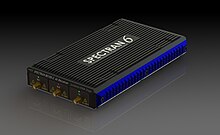
Back محلل طيف Arabic Analitzador d'espectre Catalan Spektrumanalysator Danish Spektrumanalysator German Αναλυτής φάσματος Greek Analizador de espectro Spanish تحلیلگر طیف Persian Spektrianalysaattori Finnish Analyseur de spectre French Analizador de espectro Galician


A spectrum analyzer measures the magnitude of an input signal versus frequency within the full frequency range of the instrument. The primary use is to measure the power of the spectrum of known and unknown signals. The input signal that most common spectrum analyzers measure is electrical; however, spectral compositions of other signals, such as acoustic pressure waves and optical light waves, can be considered through the use of an appropriate transducer. Spectrum analyzers for other types of signals also exist, such as optical spectrum analyzers which use direct optical techniques such as a monochromator to make measurements.
By analyzing the spectra of electrical signals, dominant frequency, power, distortion, harmonics, bandwidth, and other spectral components of a signal can be observed that are not easily detectable in time domain waveforms. These parameters are useful in the characterization of electronic devices, such as wireless transmitters.
The display of a spectrum analyzer has frequency displayed on the horizontal axis and the amplitude on the vertical axis. To the casual observer, a spectrum analyzer looks like an oscilloscope, which plots amplitude on the vertical axis but time on the horizontal axis. In fact, some lab instruments can function either as an oscilloscope or a spectrum analyzer.